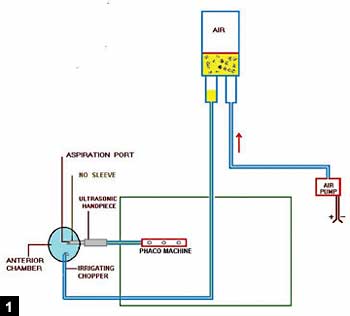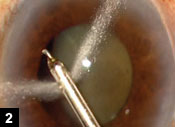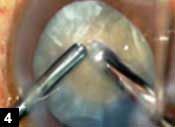Gas forced infusion offers a solution for surge
A simple air pump used in fish tanks can help prevent surge during bimanual phacoemulsification.

When we began doing bimanual phaco/phakonit, the main problem we experienced was destabilization of the anterior chamber during surgery. We solved it to a certain extent by using an 18-gauge irrigating chopper.
Then Sunita Agarwal, MD, suggested the use of an air pump, which injects air into the infusion bottle (Figure 1). The pump pushes more fluid into the eye through the irrigating chopper and as a result prevents surge. Thus we were able to use a 20-gauge or 21-gauge irrigating chopper without the problem of destabilization of the anterior chamber during surgery. Now because of gas forced infusion we are able to remove cataracts using microphakonit with a 0.7-mm irrigating chopper.
We now use this system in all our coaxial phaco cases to prevent complications such as posterior capsular rupture and corneal damage.
 Amar Agarwal |
Preventing surge
A well-maintained anterior chamber without intraocular fluctuations is one of the prerequisites for safe phacoemulsification and phakonit. When an occluded fragment is held by high vacuum and then abruptly aspirated, fluid rushes into the phaco tip to equilibrate the built-up vacuum in the aspiration line, causing surge. This leads to shallowing or collapse of the anterior chamber. Different machines employ a variety of methods to combat surge. These include the use of noncompliant tubing, small-bore aspiration line tubing, microflow tips, aspiration bypass systems, dual linear foot pedal control and incorporation of sophisticated microprocessors to sense fluctuations in the anterior chamber pressure.
The surgeon-dependent variables to counteract surge include good wound construction with minimal leakage and selection of appropriate machine parameters depending on the stage of the surgery. Michael Blumenthal, MD, has described using an anterior chamber maintainer to prevent surge.
 Diagrammatic representation of the connection of the air pump to the infusion bottle. Images: Agarwal A |
Air pump
A simple and effective method to prevent anterior chamber collapse during phacoemulsification and phakonit is by increasing the velocity of the fluid inflow into the anterior chamber. This can be achieved with the use of an automated air pump to pump atmospheric air through an air filter into the infusion bottle. Such a pump can be used with any phacoemulsification machine to minimize surge.
The air pump we use is a locally manufactured automated device, used in fish tanks to supply oxygen. The pump is available in aquarium shops. A micropore air filter is used between the air pump and the infusion bottle so that the air pumped into the bottle is clean of particulate matter and sterile.
An IV set connects the air pump to the needle, which is normally fixed for air in the infusion bottle. When the air pump is switched on, it pumps air into the infusion bottle, pushing the fluid down with greater force from the infusion bottle to the phaco handpiece or irrigating chopper (Figure 2). The fluid flow rate is much higher than normal, and it flows with more force. This extra amount of fluid prevents surge.
Continuous infusion
When the air pump is used in cataract surgery, we fill the eye with viscoelastic before we enter the eye. Once the tip of the phaco handpiece (in phaco) or irrigating chopper (in phakonit) is inside the anterior chamber, we shift to continuous irrigation. This way, the surgeon never comes to position zero, and the anterior chamber never collapses. This is helpful for surgeons who are starting phaco or phakonit and even for experienced surgeons.
With the air pump, the posterior capsule is pushed back and there is a deep anterior chamber. This prevents posterior capsular rupture.
The surgical time is shorter because without surge one can emulsify the nuclear pieces much faster. One can easily perform microphakonit with the 700-µm cataract surgical system from MicroSurgical Technology (Figure 3).
Topical or no-anesthesia surgery
When one operates under topical anesthesia or no anesthesia, sometimes the pressure in the eye is high, especially if the patient squeezes the eye. In such cases, the posterior capsule comes up anteriorly and posterior capsular rupture is possible. To solve this problem, surgeons tend to work more anteriorly, performing supracapsular phacoemulsification. The disadvantage of this is that striate keratitis tends to occur.
With the air pump, this problem does not occur. When we use the air pump, the posterior capsule is pushed posteriorly, as if we were performing surgery under a block. In other words, there is a lot of space between the posterior capsule and the cornea. This prevents striate keratitis and inadvertent posterior capsular rupture.
As striate keratitis does not occur, one can operate on hard cataracts quite comfortably (Figure 4).
|
|
|
|
Internal gas forced infusion
Arturo Pérez-Arteaga, MD, described using internal gas forced infusion for phakonit. The anterior vented gas forced infusion system (AVGFI) of the Alcon Accurus surgical system can be used for this purpose. This is a system incorporated in the Accurus machine that creates a positive infusion pressure inside the eye. This is also possible on the Bausch & Lomb Millennium machine.
Summary
Gas forced infusion helps prevent surge. This can be done using an air pump (external gas forced infusion) or using machines such as the Accurus or Millennium, which have built-in air pumps (internal gas forced infusion).
Either way, whether one does coaxial phaco or bimanual phaco this feature can help deepen the anterior chamber, prevent posterior capsular rupture and reduce the incidence of striate keratitis postoperatively.
For more information:
- Amar Agarwal, MS, FRCS, FRCOphth, director of Dr. Agarwal’s Group of Eye Hospitals, trains surgeons internationally in phacoemulsification, phakonit, LASIK and retinal lasers. Dr. Agarwal is author of several books published by SLACK Incorporated, publisher of Ocular Surgery News, including Phaco Nightmares: Conquering Cataract Catastrophes, Bimanual Phaco: Mastering the Phakonit/MICS Technique, Dry Eye: A Practical Guide to Ocular Surface Disorders and Stem Cell Surgery, and Presbyopia: A Surgical Textbook. He can be reached at 19 Cathedral Road, Chennai 600 086, India; fax: 91-44-28115871; e-mail: dragarwal@vsnl.com; Web site: www.dragarwal.com. The authors have no financial interest in the products mentioned in this article.
References:
- Agarwal S, Agarwal A, Agarwal A, eds. Phacoemulsification; 3rd ed. Thorofare, NJ; SLACK Incorporated; 2004.
- Agarwal A. Phaco Nightmares: Conquering cataract catastrophes. Thorofare, NJ: SLACK Incorporated; 2006.



